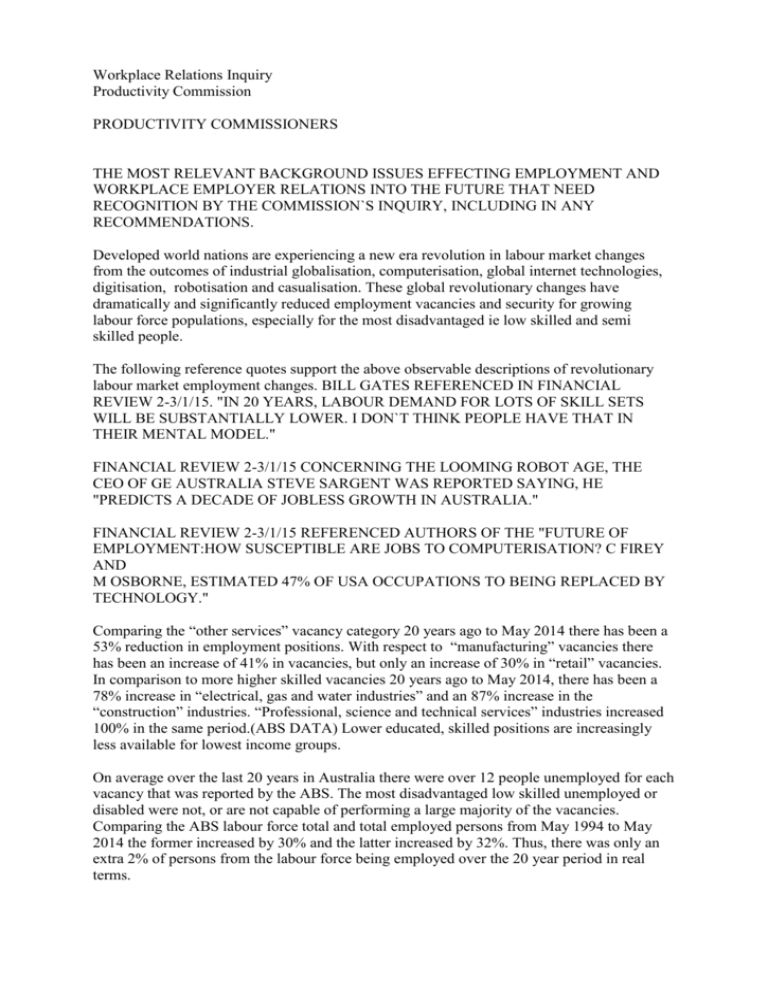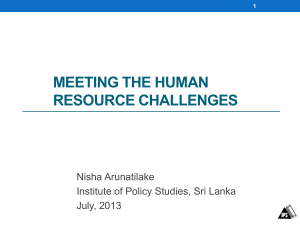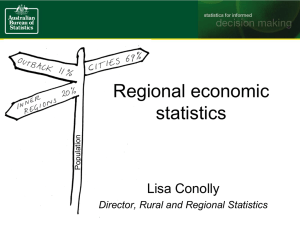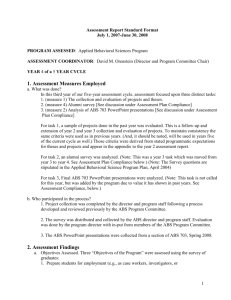Submission 101 - Graham McPherson
advertisement

Workplace Relations Inquiry Productivity Commission PRODUCTIVITY COMMISSIONERS THE MOST RELEVANT BACKGROUND ISSUES EFFECTING EMPLOYMENT AND WORKPLACE EMPLOYER RELATIONS INTO THE FUTURE THAT NEED RECOGNITION BY THE COMMISSION`S INQUIRY, INCLUDING IN ANY RECOMMENDATIONS. Developed world nations are experiencing a new era revolution in labour market changes from the outcomes of industrial globalisation, computerisation, global internet technologies, digitisation, robotisation and casualisation. These global revolutionary changes have dramatically and significantly reduced employment vacancies and security for growing labour force populations, especially for the most disadvantaged ie low skilled and semi skilled people. The following reference quotes support the above observable descriptions of revolutionary labour market employment changes. BILL GATES REFERENCED IN FINANCIAL REVIEW 2-3/1/15. "IN 20 YEARS, LABOUR DEMAND FOR LOTS OF SKILL SETS WILL BE SUBSTANTIALLY LOWER. I DON`T THINK PEOPLE HAVE THAT IN THEIR MENTAL MODEL." FINANCIAL REVIEW 2-3/1/15 CONCERNING THE LOOMING ROBOT AGE, THE CEO OF GE AUSTRALIA STEVE SARGENT WAS REPORTED SAYING, HE "PREDICTS A DECADE OF JOBLESS GROWTH IN AUSTRALIA." FINANCIAL REVIEW 2-3/1/15 REFERENCED AUTHORS OF THE "FUTURE OF EMPLOYMENT:HOW SUSCEPTIBLE ARE JOBS TO COMPUTERISATION? C FIREY AND M OSBORNE, ESTIMATED 47% OF USA OCCUPATIONS TO BEING REPLACED BY TECHNOLOGY." Comparing the “other services” vacancy category 20 years ago to May 2014 there has been a 53% reduction in employment positions. With respect to “manufacturing” vacancies there has been an increase of 41% in vacancies, but only an increase of 30% in “retail” vacancies. In comparison to more higher skilled vacancies 20 years ago to May 2014, there has been a 78% increase in “electrical, gas and water industries” and an 87% increase in the “construction” industries. “Professional, science and technical services” industries increased 100% in the same period.(ABS DATA) Lower educated, skilled positions are increasingly less available for lowest income groups. On average over the last 20 years in Australia there were over 12 people unemployed for each vacancy that was reported by the ABS. The most disadvantaged low skilled unemployed or disabled were not, or are not capable of performing a large majority of the vacancies. Comparing the ABS labour force total and total employed persons from May 1994 to May 2014 the former increased by 30% and the latter increased by 32%. Thus, there was only an extra 2% of persons from the labour force being employed over the 20 year period in real terms. On the 30/7/14 Graduate Surveys Australia reported that in the previous 12 months Australian university graduates achieved the lowest level of employment for over 20 years ie 71% Thus, even people with higher degree qualifications are increasingly experiencing issues accessing employment positions. The six unprecedented global industrial and technological changes have increasingly reduced employment vacancies during the last few decades in Australia and around the developed world. For example, an ABC RN radio documentary participant in July 2014 estimated 15% to 20% of the Australian workforce was under employed in the last two decades. It was also mentioned youth unemployment has been consistently nearly double the rate of the total adult unemployment rate during the same period. These outcomes were produced while the Australian economy achieved high GDP rates. Corporations and companies have maximised their profits by reducing employment costs employing part time, contract and casual staff when needed ie permanent staffing has been reduced dramatically. Government departments at State and Federal level have also, increasingly adopted the latter strategies to reduce employment staffing costs eg sick leave, holiday pay, and long service leave. ABS data (ABS No 6310) revealed 24% of the employed workforce did not receive any paid leave at August 2013 and the percentage was stable for 9 years. The honorary Sociologist, Eva Cox has expressed in the media there are employer cultural attitude discrimination issues that also need addressing ie most employers do not like unemployed inexperienced teenagers, the unemployed over 40 years old, the ethnic unemployed, training employees, or employing the mentally affected and disabled. eg only 2% of the federal government labour force are disabled people.(Stated by the former Disibility Discrimination Commissioner at the Press Club in mid 2014) The average annual wage increase for all employed persons was only 2.66% between November 1994 to May 2014. The average wage increase for all employed persons was only 1.6% between May 2013 to May 2014.(ABS No 6302) The average annual minimum wage increase between 2010 to July 2014 was 2.75%. The minimum weekly wage at 1/7/14 was only $640.90 (Fair Work Commission). At August 2013 the median weekly wage for all employees was only $950 (ABS No 6310). The unionised workforce has continually reduced in percentages of the employed workforce and has resulted in increasingly less annual wage increases and reduced wage increases, particularly for the less educated and skilled. Employed union membership decreased from 20% to 18% between August 2009 to August 2010 (ABS No 6310) Thus, union organisations have a reducing influence on nearly all employers concerning wage increases and employment conditions. ABS STATISTICS ON INCOME WEALTH The wealthiest 20% of households have increased their average net worth 15% since 2005-06 TO 2009/10 (CPI adjusted), while the poorest 20% of households saw only a 4% rise, according to the Australian Bureau of Statistics (ABS no. 6554). 2011/12 THE WEALTHIEST 20% OF AUST HOUSEHOLDS OWN 61% OF THE TOTAL HOUSEHOLD NET WEALTH. AVERAGE NET WEALTH OF THE WEALTHIEST WAS $2.2 MILLION. THE POOREST 20% OF HOUSEHOLDS ONLY OWN 1% OF THE TOTAL HOUSEHOLD NET WEALTH. THE AVERAGE NET WEALTH OF THESE HOUSEHOLDS WAS $31205. (ABS No 6523) The lowest income groups are increasingly receiving less net income wealth compared to the wealthier groups in Australia. For example, it was reported on ABC TV news 22/2/2015 the Fair Work Ombudsman had recovered over $23 million in under payments of wages to employees by employers in the last year. Employees subject to visa conditions were identified as a significant group being under paid. eg mostly low educated, skilled. Data was presented revealing under payments of wages by employers had increased substantially in the last three years. Low income groups have been particularly effected by the record high rental accommodation costs, national power increases of 85% in 5 years, significant water sewage cost increases and vehicle licence cost increases in the last four years. For example, Synergy WA CEO reported on the ABC Drive Program on 20/2/15 there had been an increase of 37% in customer disconnections for not paying accounts in the last 12 months. In just 2013/14 WA vehicle licences increased by 25%. The MLA for Mandurah reported in the media on 11/3/15 the WA TAFE fees for training had increased by 515% since 2013. The latter is a major issue for low skilled unemployed to access new skills training. The power nationa increase was reported on ABC RN 10/3/15 AM. "So I will come near to you for judgment. I will be quick to testify . ..............., against those who defraud laborers of their wages, who oppress the widows and the fatherless, and deprive foreigners of justice, but do not fear me," says the LORD Almighty."(Malachi 3:5) CONCLUSION It is expected the Productivity Commission will take serious acknowledgment of the presented significant information and data that has increasingly major effects on lower income groups in Australia and their ability to access employment, maintain employment and manage their budgeting. YOURS RESPECTFULLY MR GRAHAM MCPHERSON CHRISTIAN SOCIAL WORKER 33 YEARS OF PROFESSIONAL CLIENT ASSISTANCE AND ADVOCACY -NOTE: IF THE MESSAGE IS IN CAPITAL LETTERS IT IS NOT INTENDED TO OFFEND. CAPITALS ARE EASIER TO TYPE AND TO READ TO AVOID DEVELOPMENT OF FACIAL WRINKLES, INCLUDING ACCESSING STRONGER GLASS LENSES. ALSO, SAVES ON BOTOX.







